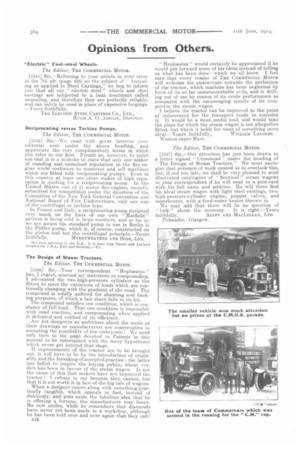Opinions from Others.
Page 20

If you've noticed an error in this article please click here to report it so we can fix it.
'Electric" Cast-steel Wheels.
The Editor, THE COMMERCIAL MOTOR.
[1341] Sir,----Referring to your article in your issue of the 7th ult. (page 2'25) on the subject of "Annealing as applied to Steel Castings," we beg to inform you that all our "electric steel" wheels and steel castings are subjected to a heat treatment called annealing, and therefore they are perfectly reliable, and can safely be used in place of expensive forgings. —Yours faithfully, THE ELECTRIC STEEL CASTINGS CO., LTD., HUGH A. 0. ADTIAIN, Director.
Reciprocating versus Turbine Pumps.
The Editor, THE C014IMERCIAL MOTOR.
[1345] Sir,—We read with great interest your editorial note under the above heading, and appreciate the very complimentary terms in which you refer to our firm. Permit us, however, to point out that it is a mistake to state that only one maker of standing and sustained reputation in the fire-engine world continues to construct and sell machines which are fitted with reciprocating pumps. Even in this country at least one other maker of high reputation is quoting for a reciprocating pump. In the United States, out of 11 motor fire-engines recently submitted for competition under the direction of the Committee of the New York General Convention and National Board of Fire Underwriters, only one was of the centrifugal or turbine type.
In France and Italy, a reciprocating pump designed very much on the lines of our own " Hatfield " pattern is being sold in large numbers, and so far as we are aware the standard pump in use in Berlin is the P!ttler pump, which is, of course, constructed on the piston and hot the centrifugal principle.—Yours faithfully, MERRYWEATHER AND SONS, LTD. [We were referring to the U.K. It is time that Dennis and Leyland invaded the U.S.A., Italy and Germany.--En.
The Design of Stearn Tractors.
The Editor, THE COMMERCIAL MOTOR.
[1346] Sir,--Your correspondent " Hephastus " has, I regret, misread my statement re compounding. I advocated the two-high-pressure cylinders as the fittest to meet the variations of loads which are continually changing with the gradient of the road. The compound is totally unfitted for shunting and backing purposes, of which a fair share falls to its lot. The compound satisfies one condition, which is constancy of full load. That one condition is impossible with road traction, and compounding when applied is defeated and robbed of its efficiency. Are not designers as ambitious about the merit of -their drawings as manufacturers are conservative in accepting the possibility of the embryonic ? We need only turn to the page devoted to Patents in this journal to be entertained with the many hypotheses which never get beyond that stage.
If improvements of the tractor are to be brought out, it will have to be by the introduction of origin-j ality and the forsaking of accepted practice ; the latter has failed to inspire the buying public, whose verdict has been in favour of the steam wagon. Is not the cause of this that makers have not improved the tractor'? I refrain to say because they cannot, but that it is not worth it in face of the big sale of wagons.
When a designer comes along with something practically tangible, which appeals in fact, instead of dubiously, and puts aside the fabulous idea that lie is offering a fortune, the manufacturer may listen. He now smiles, while he remembers that diamonds have never yet been made in a workshop, although he has been told over and over again that they can!
D12
" Hephastus" would certainly be appreciated if he would put forward some of his ideas instead of telling us what has been done—which we all know. 1 feel sure that every reader of THE COMMERCIAL MOTOR will welcome his endeavours towards the perfection of the tractor, which machine has been neglected by force of its so far unsurmountable evils, and is drifting out of use by reason of its crude performance as compared with the encouraging results of its competitor the steam wagon. I believe the tractor can be improved to the point of inducement for the transport trade to consider it. It would be a most useful tool, and would take the place for which the steam wagon is not altogether fitted, but which it holds for want of something nore ideal.—Yours faithfully, WILLIAM LALONDE. Weston-super-Mare.
The Editor, THE COMMERCIAL MOTOR.
[1:347] Sir,—Our attention has just been drawn to a letter signed " Crossh.eael " under the heading of "The Design of Steam Tractors." We must apologize that pressure of work caused us to overlook this, but, if not too late, we shall be very pleased to send illustrated catalogues of " Sentinel" steam wagons to your correspondent if he will send us a. post-card with his full name and address. He will there find his ideal steam wagon with light steel castings, twohigh-pressure-cylinder engine, poppet valves, and superheater, with a feed-water heater thrown in. We may add that there will be no question of "luck" about the economy. It is right.—Yours
faithfully, ALLEY AND MACLELLAN, LTD. Polmadie, Glasgow.

























